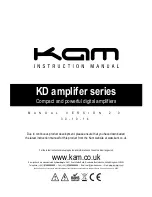
Page 32 of 42
INSTRUCTION MANUAL
ARI-6000-100W
RF Power Amplifier
SECTI ON 5
-
OPERATION
1912 1 E l T o ro R d
●
Si l vera do, Ca lifo rni a 9 26 76
●
(9 49) 459 -96 00
●
co m-p o wer. com
REV011718
5.2.2.3 Status Reporting
Status reporting, i.e., the setting of the Service Request (SRQ)
line and status bits in the Event Status Register and Status Byte
register (STB), are handled per tailored requirements of IEEE-
488.2. The reporting structure is presented in Figure 5. This figure
shows which status bits are used and which are always a logic
zero.
Important Considerations:
1. The ESE and SRE registers have default values of all zeros. If
status reporting is desired, these registers must be initialized
whenever power to the amplifier is cycled.
2. Once the SRQ is asserted, then a serial poll command will un-
assert the SRQ. However, the STB and ESR registers will not
clear until an *CLS command is received.
The recommended/expected response to a service request is
as follows:
1. The GPIB controller conducts a serial poll to determine which
instrument made the request (asserted the SRQ flag). If serial
polling is not used, then the controller could read the Status
Byte, via the *STB? query to determine if a specific instrument
made the request.
2. Issue the standard clear serial poll command if serial polling
is used.
3. Read the Event Status Register, via the *ESR? Query to
determine the reason for the service request.
4. If the User Request bit in the ESR is set, a fault condition
occurred in the amplifier. Read the status of the amplifier’s
monitors via the Monitors? query.
5. Clear the ESR and monitor status registers via the *CLS
command. Note that the *CLS clears both the GPIB registers
(ESR and STB) and acknowledges faults (i.e., has the effect of
issuing the ACK faults command). If a serial poll command
was not used, the SRQ line is un-asserted via the *CLS
command.











































